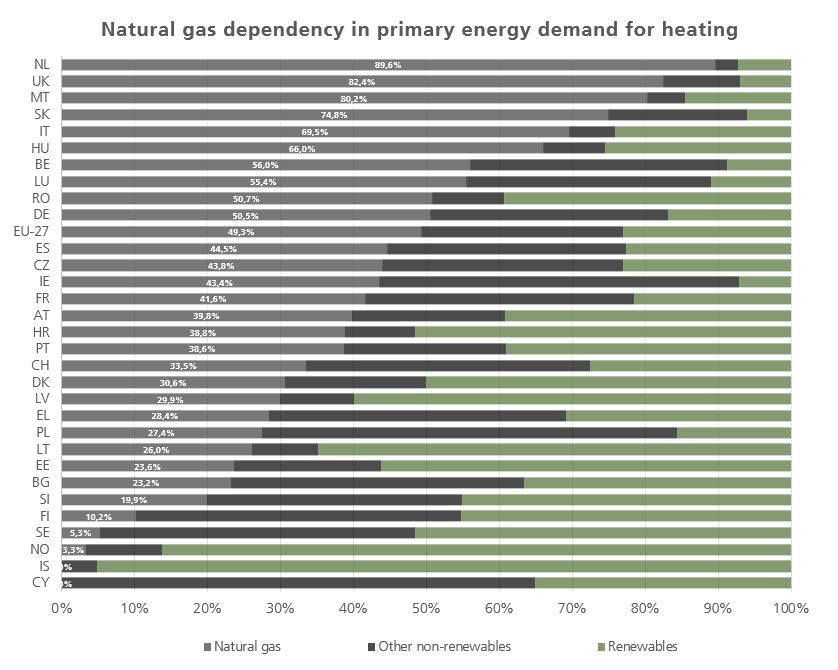New data set reveals the natural gas dependency of space heating in several EU countries
The space and water heating sector accounts for almost one third of Europe’s final energy consumption and is still dominated by fossil fuel use, most importantly natural gas. A new data set, developed in the context of the study “Renewable Space Heating under the Revised Renewable Energy Directive“ by TU Wien, Fraunhofer ISI, e-think, Öko-Institut and Viegang Maagoe reveals that, in the EU27, natural gas supplies almost 50 percent of space heating. The dependency on natural gas, however, varies strongly across countries, ranging from 0 to 90%. The study aims to provide a better information basis for policy design targeting decarbonization, and the newly published open data set that contains summaries for all EU27 countries allows users to explore the structure of space heating demand and supply in these countries.
Across Europe, space heating depends strongly on natural gas. In terms of primary energy, natural gas accounts for almost 50% of the energy demand for space heating. A proportion of this is the natural gas used for district heating and electricity generation. The natural gas dependency of space heating is even higher in some EU countries: In the Netherlands, for example, natural gas supplies close to 90% of space heating and more than 60% in countries like Malta, Slovakia, Italy and Hungary.
With a share of about 50%, Germany is close to the EU average. Among the least dependent countries are Sweden and Finland with 5 and 10%, respectively. Many Eastern European member states also have a substantially lower natural gas dependency than the EU average: In Slovakia, Bulgaria, Estonia, Lithuania and Poland, the share of natural gas in space heating is below 30%.
Excluding biomass, the share of renewable energies is still extremely low in the EU and the transition of the heating sector is only just beginning
Compared to natural gas, renewable energies still play a minor role in space heating supply in most countries. The renewable share of the EU-27's primary energy fuel mix is estimated at 23%, while 77% is still based on fossil fuels. Biomass is the single most important renewable energy and accounts for about 16% of the total.

Emerging energy carriers and technologies such as heat pumps, solar thermal and geothermal energy are still niche markets in most countries, with a total share of approximately 4% in the final energy demand for space and water heating. However, they have a key role to play in the long-term transition, indicating how much change still lies ahead of the space heating sector.
While all the above-mentioned data were compiled for the year 2018, they still describe today's situation relatively well, because changes in the space heating sector are so slow.
Building renovations, heat pumps and district heating expansion are no-regret strategies, which are central in all six scenarios of the study.
Based on these collected data, the study developed six decarbonization scenarios for space and water heating until 2050 to better understand the long-term perspectives and related costs. To do so, three detailed energy models were applied: the TU Wien’s building stock model Invert and its Hotmaps district heating model, and Fraunhofer ISI’s energy system optimization model Enertile.
Overall, the following main insights can be derived from the scenario modeling:
- If the measures and the overall system are optimized as assumed in our modeling approach, the costs of many scenarios are in a similar order of magnitude. More relevant than the cost factor are the barriers and policy implications for a decision in favor of a particular pathway.
- Some measures can be regarded as no-regret options, as they play a strong role in all scenarios. These include a high level of building renovation, and a high diffusion of heat pumps and district heating in suitable areas.
- The best-case scenario – meaning it results in the lowest system cost – is similar to the electrification scenario, but with slightly higher penetration of solar heat and district heating.
Dr Tobias Fleiter, who coordinated the Fraunhofer ISI’s research in the study, states: “Our study reveals the strong dependency on fossil energy sources in the European space heating sector and the still minor role of renewable energies in most countries. Natural gas is the dominant fuel supply in most EU countries. The scenario analysis also indicates that heat pumps and district heating are no-regret options that all member states should scale up rapidly with high priority. Here, the markets are still underdeveloped in many countries. Financial incentives and measures to support market transformation and capacity building to support planning skills in local administrations are needed. On the other side, the regulatory framework also needs to prevent new investments in fossil heating systems, because these will have a lock-in effect on the system for the next 20 years. Finally, the role of infrastructure like district heating, gas and electricity grids is key and new approaches to heat planning and citizen involvement are needed to coordinate the expansion, modernization and decommissioning of such infrastructures. These strategies not only decarbonize the heating sector, but also bring substantial relief in the current gas crisis."
The Fraunhofer Institute for Systems and Innovation Research ISI analyzes the origins and impacts of innovations. We research the short- and long-term developments of innovation processes and the impacts of new technologies and services on society. On this basis, we are able to provide our clients from industry, politics and science with recommendations for action and perspectives for key decisions. Our expertise is founded on our scientific competence as well as an interdisciplinary and systemic research approach.